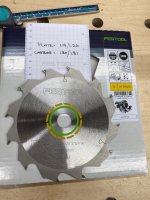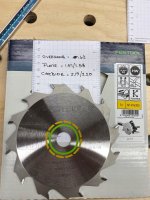Hi!
I recently bought a TS 55 R plunge saw (just missed the new TS 55 F) for breaking down sheet goods (mostly 18 mm plywood). It came with a W48 blade, which I suppose will serve me well, even if it, strictly speaking, is not designed for ripping.
I have a project coming up where I will have to make a straight edge on two pieces of 50 mm thick ash. They are 3,5 m long and 600-780 mm wide, so they are quite heavy. Ripping them on my jobsite table saw seems difficult and I would have to make a jig for it, as they don't have a straight edge, I need to make one.
So, I want to see if I can use my TS 55 for this. I realise it will be taxing and I may have to do it in two or more passes.
I've been looking for a Panther blade, ie the PW12 one, to use for this. Figure I might as well use it for ripping plywood as well and save the W48 blade for cross cutting. Unfortunately, I can't find a vendor that has the PW12 with 2,2 mm kerf in stock untill it is too late for me.
My options are:
-Buy a W18 universal blade instead. Would certainly be more versatile.
-Buy a Panther PW12 blade with 1,8 mm kerf. Would probably rip the ash more effectively and the thinner blade would mean the under-powered (for the job) saw would perform better. But that would mean my rip cuts would not follow my tracks.
I would appreciate your opinions and experiences of using thinner blades or a mixture of blades with different thicknesses. Does it bother you that the cut does not follow the track in the same way? I'd imagine that this would mean the cut ending up1,5 0,2 mm from the track. There are some older threads though from before they standardised the blades where people seem to have varying experiences with this, the difference in some cases being bigger (because of alignment, maybe?).
Anyway, long story short. If you were buying a single ripping blade for a TS 55 R that also has a W48 2,2 mm - would you choose the PW12 1,8 mm or the W18 2,2 mm?
I recently bought a TS 55 R plunge saw (just missed the new TS 55 F) for breaking down sheet goods (mostly 18 mm plywood). It came with a W48 blade, which I suppose will serve me well, even if it, strictly speaking, is not designed for ripping.
I have a project coming up where I will have to make a straight edge on two pieces of 50 mm thick ash. They are 3,5 m long and 600-780 mm wide, so they are quite heavy. Ripping them on my jobsite table saw seems difficult and I would have to make a jig for it, as they don't have a straight edge, I need to make one.
So, I want to see if I can use my TS 55 for this. I realise it will be taxing and I may have to do it in two or more passes.
I've been looking for a Panther blade, ie the PW12 one, to use for this. Figure I might as well use it for ripping plywood as well and save the W48 blade for cross cutting. Unfortunately, I can't find a vendor that has the PW12 with 2,2 mm kerf in stock untill it is too late for me.
My options are:
-Buy a W18 universal blade instead. Would certainly be more versatile.
-Buy a Panther PW12 blade with 1,8 mm kerf. Would probably rip the ash more effectively and the thinner blade would mean the under-powered (for the job) saw would perform better. But that would mean my rip cuts would not follow my tracks.
I would appreciate your opinions and experiences of using thinner blades or a mixture of blades with different thicknesses. Does it bother you that the cut does not follow the track in the same way? I'd imagine that this would mean the cut ending up
Anyway, long story short. If you were buying a single ripping blade for a TS 55 R that also has a W48 2,2 mm - would you choose the PW12 1,8 mm or the W18 2,2 mm?


